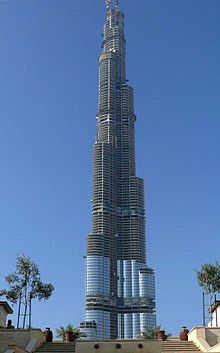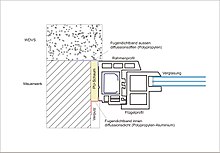Window construction



Window construction is a technical business field, the aim of which is to produce windows , window systems and curtain walls for buildings. This also includes house doors and house door systems. Due to the different materials to be used in a complex system, window construction includes various technical disciplines from manufacture to installation. Above all, the glazier trade , sealing technology , electrical engineering , assembly and, depending on the frame material used, metal construction , plastics technology or the carpentry trade .
Windows are either individually manufactured or made from prefabricated profiles made to measure or in series . Curtain walls are usually created from special, technically very complex systems and consist of a grid-type mullion-transom support system as well as various glass or closed facade elements, the so-called fillings. In some cases, roller shutters , sun protection systems , ventilation systems or photovoltaic systems are integrated.
Systems
Basically, one thing is the same for all window systems: They consist of profiles for frames and sashes, a panel and a range of fittings and components for the technical functions. Today , balcony doors are mostly made with standard window profiles; The profiles used for house doors are only slightly different. With the exception of larger mullion-transom systems (such as shop window systems or curtain walls), assembly is the same for all window systems. The window frame is inserted into the prepared wall opening, dowelled, foamed and sealed. Then the prefabricated sashes including glazing or fixed glazing are installed. The technical requirements for installation are to prevent the frame from warping when dowelling and foaming, to create a tight connection to the neighboring structural elements and to ensure water drainage, which in many cases also occurs through the interior of the profiles. The requirements of the Gütegemeinschaft Fenster und Haustüren e. V. , the so-called RAL assembly .
In addition to a series of standards and guidelines for all aspects of window construction from glass to sound insulation , all essential requirements for windows and doors are dealt with in DIN -EN-14351.
Because of the different material properties, a distinction is made here between the various frame systems.
Wooden window
In the case of wooden windows, the profiles used are made of wood , mostly solid wood , with its good static properties. The disadvantage of wooden windows is their weight and limited weather resistance. Wood-aluminum windows are a special form. Essentially wooden windows, which are additionally protected against weathering by an external aluminum profile.
Plastic windows
Plastic windows consist of an extruded plastic profile , mostly made of PVC , in which, for structural reasons, a steel square tube, a steel U-profile or an L-profile is almost always incorporated. Without this reinforcement, the rigidity is relatively low and thus the wing width of the window is limited. Three- chamber profiles with a window frame depth of 50 mm were previously common; Windows sold today (2015) often have five-chamber profiles and a frame depth of 70 mm. The latter have better thermal resistance and can also accommodate triple-glazed panes. In order to meet the requirements of "EnEV 2014" for windows in new buildings , frame depths of over 70 mm are required.
Aluminum windows
Aluminum windows are made from extruded aluminum profiles. They are particularly light, sufficiently stable and weatherproof.
Steel windows
Steel windows consist of rolled steel profiles and, in addition to design reasons, are used when special requirements for static load capacity have to be met.
Facades
Curtain walls or window systems made from a post-and-rail system are a specialty. Posts are usually made of aluminum or steel and are attached to the ceilings and connected to a grid with crossbars. Glazing, closed panels or window sashes are then inserted into the fields. In principle, it is also possible to assemble completely prefabricated elements that extend over several floors. This method is mainly used for larger construction projects and is one of the best in window construction.
Economical meaning
The window construction industry is divided into three levels with different protagonists . On the one hand, there are some very large industrial companies that manufacture window profiles. The best known are, among others, Schüco or VEKA . On the next level there is a large number of medium-sized companies that either manufacture windows from the prefabricated profiles of the well-known manufacturers or, for example, as a carpentry shop, also manufacture all frame components themselves. Smaller specialized assembly companies or I-AGs are often used as subcontractors for on-site assembly . There are also a number of suppliers for the window industry who manufacture fittings, glasses and seals. Companies in the field of window construction belong to the IHK and are organized in different associations.
According to a study by the VFF (Association of Windows and Facades) from 2011, there are around 58,000 companies with around 300,000 employees in the German window and facade industry, including all downstream branches of industry. They generate a total of around 34 billion euros per year.
Historical development
In the course of the increasingly complex demands on windows and the specialization that became necessary, window construction developed into an independent business field from around 1950, especially with the introduction of plastics as window frame material from sub-areas of the glazing and carpentry trade.
Job profile window manufacturer in German-speaking countries
In Germany, window or glass facade construction is a recognized apprenticeship with a three-year apprenticeship period . The training ends with the journeyman's examination , which is taken in front of the Chamber of Crafts . A master craftsman examination is possible after six years as a trainee. Since 2006 there has also been an apprenticeship as a plastic window maker.
In Austria , a comparable training is that of the glass construction technician with three to four years of training.
In Switzerland , the apprenticeship as a carpenter (EFZ) with a focus on construction / windows as well as further training or additional qualification by the Swiss Association of Window and Facade Industry (FFF) to become a window maker with a focus on "Avor", "Production" and "Assembly" takes place ".
In addition to the above, a whole range of other apprenticeships allow employment in window construction. The planning is done by architects , civil engineers and specialized planners.
See also
Individual evidence
- ↑ RAL Gütegemeinschaft Fenster und Frontüren e. V .: Guideline for the planning and execution of the installation of windows and house doors for new buildings and renovations. Association of window and facade manufacturers, March 2014, accessed on May 15, 2015 .
- ↑ DIN standards. Federal Working Group Old Building Renewal, accessed on May 15, 2015 .
- ↑ Ulrich Sieberath, Christian Niemölle: Commentary on DIN EN 14351-1 windows and doors. ift Rosenheim, accessed on May 15, 2015 .
- ↑ www.enev-online.com
- ^ Association Windows + Facade: Window and door industry: Current total figures for Europe. April 7, 2015, accessed May 15, 2015 .
- ↑ BERUFENET - find job information easily. Retrieved September 6, 2017 .
- ↑ Article by Alfons Oebbeke: The plastic window construction receives its own apprenticeship. baulinks, March 27, 2006, accessed May 15, 2015 .
- ↑ Glass construction technology (modular apprenticeship). Institute for Economic Research in Education, accessed on May 19, 2015 .
- ↑ Window construction structural knowledge. FFF, accessed June 10, 2015 .
